Viewfinder and Rear Screen
One of the main differences between the X-T10 and the X-T1 is the T10’s smaller viewfinder. The electronic viewfinder (EVF) of the X-T10 has the same 2.3 million dot EVF panel, but the optics used for display of that viewfinder produce an image that is notably smaller than the rather huge viewfinder of the X-T1. The X-T10’s EVF has a magnification of 0.62x (considering a ‘normal’ lens), which is about the size of a typical APS-C sized DSLR viewfinder. This is in contrast to the massive 0.77x finder in the X-T1, which is larger than most full-frame DSLR viewfinders. The 0.62x size is roughly the same as the one found in the X-E2, though contrast appeared a bit better to my eye, and more on-par with the X-T1’s finder in that regard.
The X-T10’s viewfinder also inherits the T1’s rotating EVF display, such that shooting information will rotate orientation when the camera is in portrait orientation. This works smoothly, but in consideration of the smaller view, the bottom information line actually wraps to a second line in the portrait orientation.

The rear screen on the X-T10 is a 3″ panel with 920,000 dots. The rear screen is constructed similarly to the one on the X-M1 and X-A1/A2, which is strong and moves easily, though it’s a bit thicker than the one on the X-T1. The screen can be tilted down at 45 degrees or laid flat, aimed 90 degrees upward, allowing for easy waist level shooting or using the camera with ease low to the ground.
I find the rear screen to be bright and contrasty with good detail and relatively accurate color. There still is somewhat of a mismatch between what’s visible on the screen and what the final image will look like on your computer, but it’s not a huge difference. Both the EVF and rear screen are in line with what I’d expect out of a camera in this price range.
Autofocus and Performance
The headline feature on the X-T10 is the all-new autofocus system, which further improves on Fuji’s AF algorithms. The AF system that debuts with the X-T10 was also brought to the X-T1 via the recent v.4.0 firmware update, but the X-T10 is the first camera to feature this improved autofocus out of the box.
The X-T10’s AF is a hybrid contrast and phase-detection system, with 15 phase detection AF points in the central area of the image frame, in conjunction with contrast detect capabilities over the entire image frame. Fuji’s been making continued strides in the autofocus arena every year, and with the X-T10, that system has finally reached maturity. Instead of simply choosing one focus point or letting the camera choose any point, there are now three modes for AF: Single point, Zone AF or Wide-Area AF.

The Single point system is the same 49 point affair as on previous cameras, with the central 9 focus points containing phase-detect information. Any of these modes can be used with both single shot or continuous autofocus as selected by the switch on the front of the camera.
Overall performance with single shot AF is improved from previous X-series cameras, especially with lenses like the 27mm f/2.8 and 35mm f/1.4. Both of these lenses see dramatic speed increases with far less hunting versus early X series cameras. Low light accuracy is also improved, with less hunting and an ability to lock on surely even in very dim conditions.
When using continuous autofocus, the new modes shine. While single point continuous AF is still good, and perhaps slightly improved, the camera shines when using the new Zone AF with continuous autofocus. Zone AF allows you to select groupings of 3×3, 5×3 or 5×5 focus points from which the camera will find focus. The Zone AF system, especially when the points in the central PDAF zone are used, dramatically improves continuous autofocus.
Using 5×3 Zone AF, I experienced very accurate predictive autofocus in high-speed burst mode, even with slower focusing lenses like the 35mm f/1.4. The system proved capable of handling even challenging situations like in the image below, where the subject was quickly, but somewhat erratically, running towards the camera. The X-T10 was able to track her movement and nail focus, even with the very slim depth of field at 56mm and f/1.4.

The Wide-Area AF mode uses the entirety of the image sensor for focusing, but due to the wide field, you still specify an autofocus point, which is where the camera first looks for focus. After focus is achieved, it will attempt to track that subject across the entire image frame, regardless of where it moves. Because the wide-area AF uses contrast detection over most of the frame, it is not as adept at tracking motion that moves toward or away from the camera, though it can be a useful mode for following lateral action or slow-moving subjects.
The X-T10 also has a new and improved face-detection algorithm that can seek out individual eyes. Settings allow preference for the right or left eye, or to allow the camera to determine which eye to focus on. I found this feature to work quite well, and a very high percentage of shots were absolutely dead-on in focus using this mode. It’s a great mode for capturing candids of children, given their unpredictable movement and how the framing may suddenly change.

In all, I find the X-T10’s autofocus upgrades to be excellent. As the X-T1 now shares this same system, the X-T series as a whole clearly sits at the top of the heap of Fuji cameras with regards to autofocus performance. While Panasonic and Olympus are still a bit faster in single shot shooting, and the Sony a6000 may have slightly better continuous AF (though it’s very close), the X-T10’s autofocus is predominantly on par with the competition in most circumstances, and the continuous AF in Zone AF mode is near the top of the heap among mirrorless cameras.
Performance
The X-T10 may focus quickly, but how does it do with overall performance and responsiveness? Well, there are positives and negatives here. On the plus side, the camera has the same processor and general speed of the more expensive X-T1. Files write the card fairly quickly and the camera turns on and is ready without much delay. There’s generally no waiting on the camera in everyday operation. So, in this regard, there’s nothing to complain about.
The X-T10, like the X-T1 before it, has a top continuous burst speed of 8 frames per second. This is fairly quick, though the 11fps of the Sony a6000 and the crazy high 15 fps of the Samsung NX1 both are faster. However, it’s worth noting that the 8fps top burst speed is generally only available when shooting with a fixed focus point or in manual focus, as the burst rate slows down to maintain focus during continuous AF operations. Depending on lens focus speed, the slowdown can be appreciable, with some bursts slowing to around 4fps during tracking.
However, the biggest impediment to using the camera for shooting action isn’t with the burst slowdown, but rather with the exceptionally small buffer. While the X-T1 can rattle off around 20 RAW photos at 8fps, the X-T10 can manage only 7. Even switching to JPEG raises that number to only 8. That means an 8fps burst won’t even capture one full second of action when shooting RAW. That means timing is critical. While the buffer flushes moderately quickly, you are still going to have to wait a few seconds before another bust can be taken.
Flash
The X-T10 hides a small pop-up flash in the viewfinder hump of the camera. As I mentioned earlier, this flash is released with a small switch located to the side of the drive mode dial. The flash deploys instantly. It pops up faster than any other pop-up flash I”ve seen. It’s almost freaky quick. However, the actual usage of the flash is simply typical of a small pop-up flash. It can be useful for some fill-in flash here and there, or for throwing light during macro shooting, but the small height of the flash gives the rather ugly look that is typical of a small direct flash. The flash is also really only useful with the smaller lenses in the Fuji system.

I had no issues with the 27mm f/2.8, 35mm f/1.4, 60mm f/2.4 or even the 18-55mm f/2.8-4. However, the larger lenses, such as the 10-24mm f/4, 23mm f/1.4 and 56mm f/1.2 caused a shadow in the lower part of the image frame when using the pop-up flash.





Leave a Reply